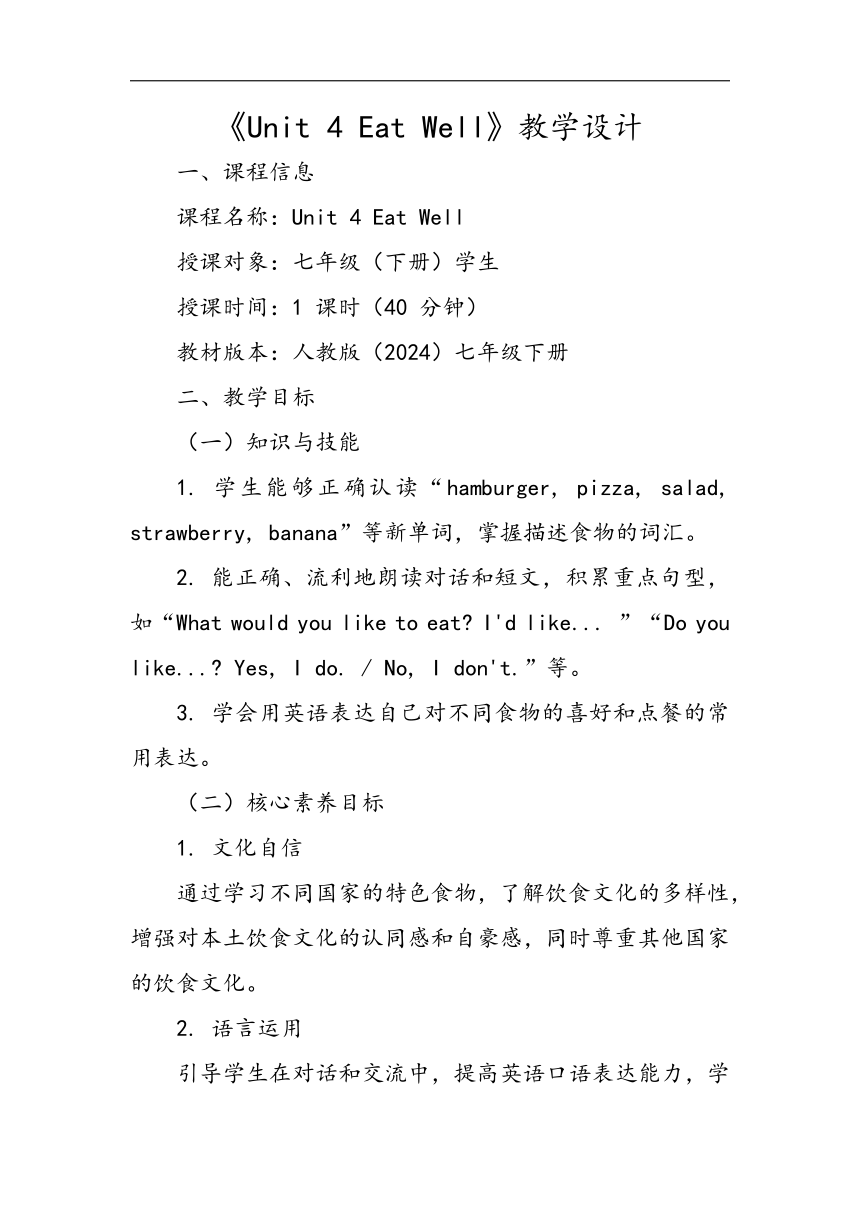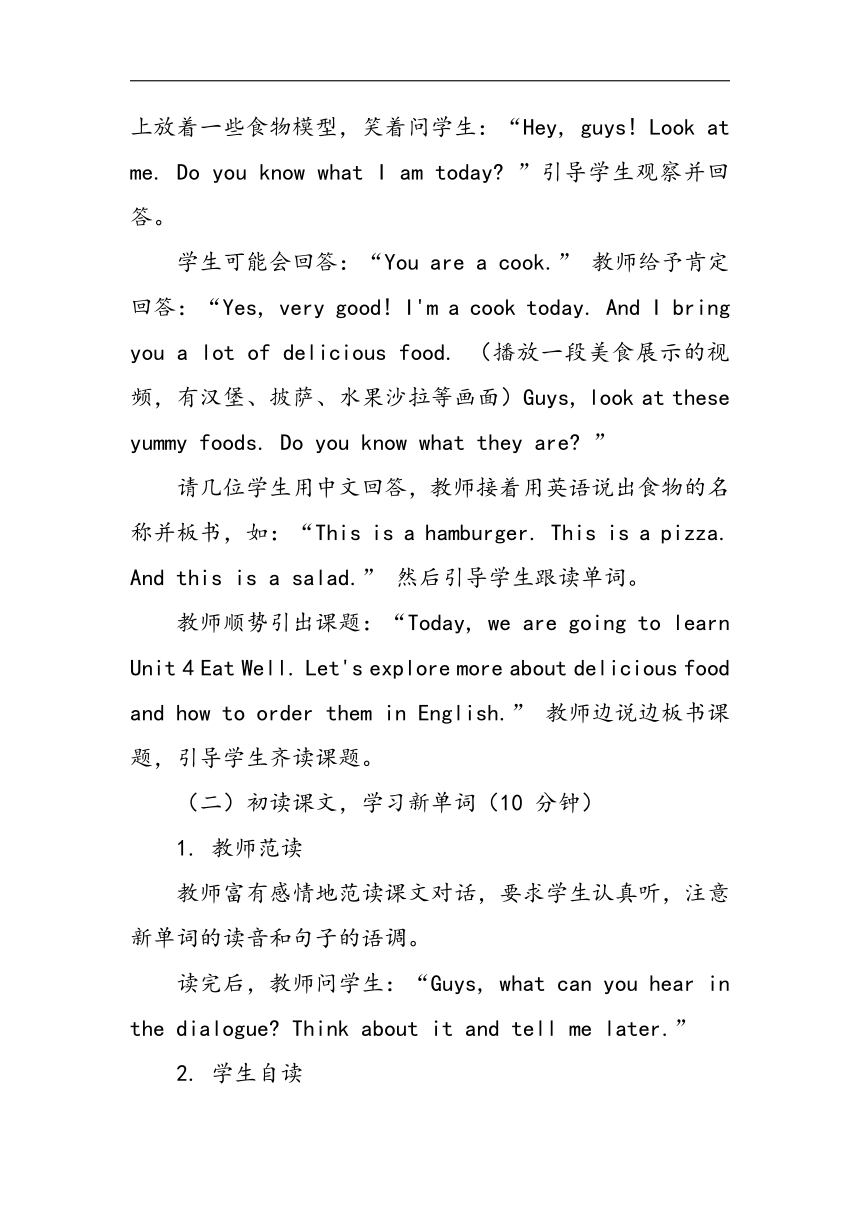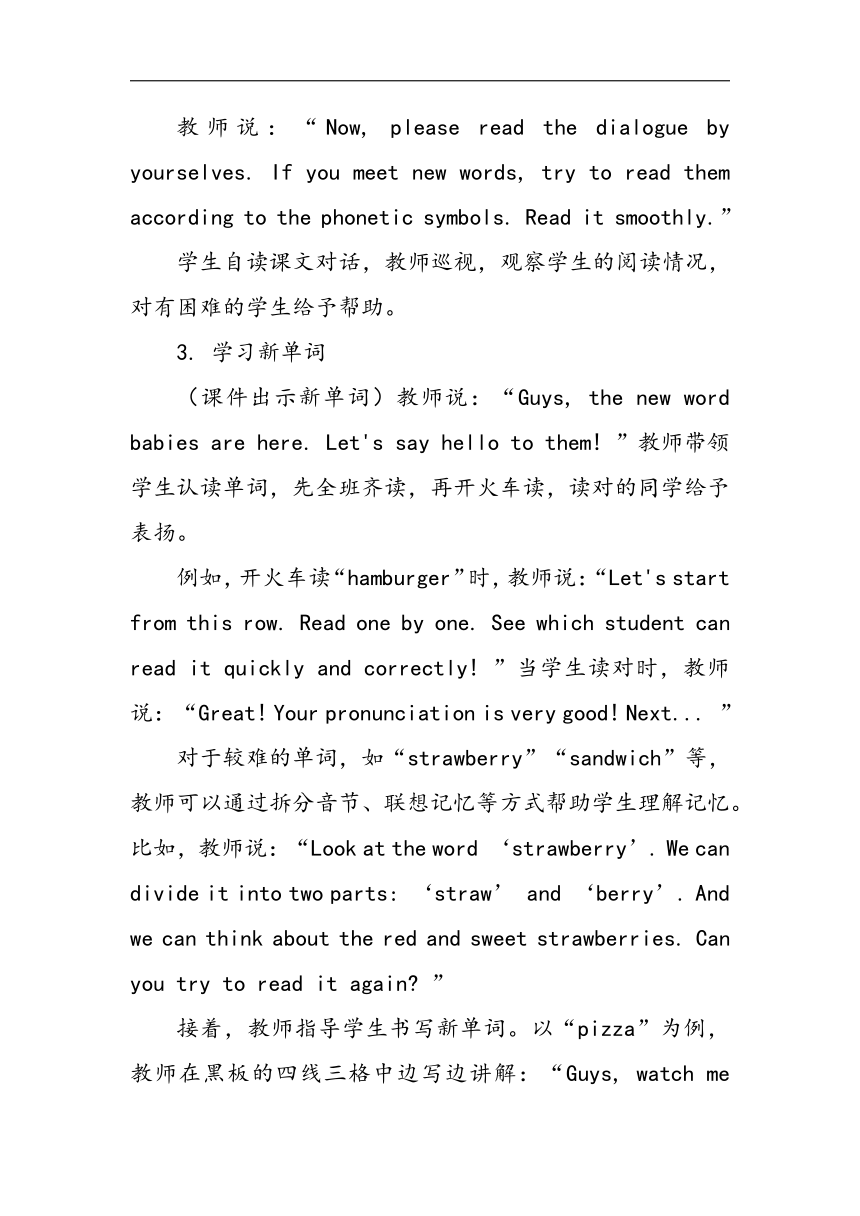 资源简介
资源简介
《Unit 4 Eat Well》教学设计
一、课程信息
课程名称:Unit 4 Eat Well
授课对象:七年级(下册)学生
授课时间:1 课时(40 分钟)
教材版本:人教版(2024)七年级下册
二、教学目标
(一)知识与技能
1. 学生能够正确认读“hamburger, pizza, salad, strawberry, banana”等新单词,掌握描述食物的词汇。
2. 能正确、流利地朗读对话和短文,积累重点句型,如“What would you like to eat I'd like... ”“Do you like... Yes, I do. / No, I don't.”等。
3. 学会用英语表达自己对不同食物的喜好和点餐的常用表达。
(二)核心素养目标
1. 文化自信
通过学习不同国家的特色食物,了解饮食文化的多样性,增强对本土饮食文化的认同感和自豪感,同时尊重其他国家的饮食文化。
2. 语言运用
引导学生在对话和交流中,提高英语口语表达能力,学会用英语准确地描述食物和表达自己的饮食偏好。
3. 思维能力
培养学生观察图片、理解文本的思维能力,通过思考问题和小组讨论,提升逻辑思维和创新思维能力。
4. 审美创造
体会文中对食物的描述,感受英语语言的优美,培养学生对英语学习的兴趣和审美情趣。
三、教学重难点
(一)教学重点
1. 掌握新单词的读音和拼写,理解课文对话内容。
2. 学会用英语表达自己对食物的喜好和进行点餐交流。
(二)教学难点
1. 能够在实际情境中灵活运用所学的食物词汇和句型进行自然流畅的交流。
2. 引导学生了解不同食物的营养价值,树立健康饮食的观念。
四、教学方法
讲授法、直观演示法、讨论法、角色扮演法
五、教学过程
(一)导入新课(5 分钟)
1. 情境导入
教师戴着一顶厨师帽,推着一个小餐车走进教室,餐车上放着一些食物模型,笑着问学生:“Hey, guys! Look at me. Do you know what I am today ”引导学生观察并回答。
学生可能会回答:“You are a cook.” 教师给予肯定回答:“Yes, very good! I'm a cook today. And I bring you a lot of delicious food. (播放一段美食展示的视频,有汉堡、披萨、水果沙拉等画面)Guys, look at these yummy foods. Do you know what they are ”
请几位学生用中文回答,教师接着用英语说出食物的名称并板书,如:“This is a hamburger. This is a pizza. And this is a salad.” 然后引导学生跟读单词。
教师顺势引出课题:“Today, we are going to learn Unit 4 Eat Well. Let's explore more about delicious food and how to order them in English.” 教师边说边板书课题,引导学生齐读课题。
(二)初读课文,学习新单词(10 分钟)
1. 教师范读
教师富有感情地范读课文对话,要求学生认真听,注意新单词的读音和句子的语调。
读完后,教师问学生:“Guys, what can you hear in the dialogue Think about it and tell me later.”
2. 学生自读
教师说:“Now, please read the dialogue by yourselves. If you meet new words, try to read them according to the phonetic symbols. Read it smoothly.”
学生自读课文对话,教师巡视,观察学生的阅读情况,对有困难的学生给予帮助。
3. 学习新单词
(课件出示新单词)教师说:“Guys, the new word babies are here. Let's say hello to them! ”教师带领学生认读单词,先全班齐读,再开火车读,读对的同学给予表扬。
例如,开火车读“hamburger”时,教师说:“Let's start from this row. Read one by one. See which student can read it quickly and correctly! ”当学生读对时,教师说:“Great! Your pronunciation is very good! Next... ”
对于较难的单词,如“strawberry”“sandwich”等,教师可以通过拆分音节、联想记忆等方式帮助学生理解记忆。比如,教师说:“Look at the word ‘strawberry’. We can divide it into two parts: ‘straw’ and ‘berry’. And we can think about the red and sweet strawberries. Can you try to read it again ”
接着,教师指导学生书写新单词。以“pizza”为例,教师在黑板的四线三格中边写边讲解:“Guys, watch me write ‘pizza’. First, write the letter ‘p’, then two ‘i’s and two ‘z’s. Pay attention to the writing rules. Now, stretch out your hands and write in the air with me. ”学生书空后,让学生在练习本上写 3 5 个,教师巡视指导,纠正学生的书写姿势和字母的大小写。
(三)精读课文,理解内容(18 分钟)
1. 学习对话第一段
教师引导学生朗读对话第一段,读完后问:“Guys, who are talking in this part And what are they talking about ”
学生回答后,教师总结:“Yes, it's a customer and a waiter. They are talking about the menu. What can we see on the menu according to the dialogue ”引导学生找出菜单上的食物名称。
2. 学习对话第二段
(课件出示餐厅点餐的图片)教师说:“Guys, look at this picture. Imagine you are in a restaurant. If you are the customer, what would you like to order Let's listen to the dialogue and find out what the customer wants. ”
学生听完后,教师问:“What would the customer like to eat ”学生回答:“He'd like a hamburger and a glass of cola.” 教师接着问:“How about you What would you like to eat if you are in a restaurant ”请几位学生回答,引导他们用 “I'd like... ” 句型表达。
教师带领学生朗读这一段对话,感受点餐的情境。读完后,教师说:“Now, let's role play this part. One student is the customer and the other is the waiter. Practice with your partner. ”学生进行角色扮演,教师巡视并给予指导。
3. 学习对话第三段
教师说:“Guys, after the customer orders the food, what does the waiter say Let's read this part together. ”
学生读完后,教师问:“Does the waiter confirm the order correctly ”引导学生回答问题并理解对话内容。
教师接着说:“Now, I want two students to come to the front of the class and act out this part. Let's see who can act it best. ”请两位学生上台表演,其他学生认真观看。表演结束后,教师给予评价和鼓励。
4. 学习对话第四段
教师引导学生朗读对话第四段,读完后问:“Guys, do you think the customer is satisfied with the order How can you tell ”
学生回答后,教师总结:“From the dialogue, we can know that the customer is satisfied. Because he says ‘That's fine.’ Now, let's discuss in groups. If you were the customer, would you be satisfied with this service And why ”
学生分组讨论,教师巡视倾听。讨论结束后,每个小组派代表分享他们的观点。
5. 拓展知识
教师问:“Guys, we know many kinds of food from the dialogue. But do you know which foods are healthy and which are not ”
先请学生说一说自己的想法,然后教师进行总结:“Generally speaking, fruits like strawberries and bananas, and vegetables like lettuce in the salad are healthy foods. They are rich in vitamins and fiber. While hamburgers and pizzas with a lot of meat and cheese are not very healthy if we eat too much. They are high in fat and calories. We should eat a balanced diet to keep healthy. ”
(四)课堂小结(4 分钟)
1. 教师总结
教师说:“Guys, today we have learned Unit 4 Eat Well. We've learned a lot of new words about food, how to order food in a restaurant, and also the knowledge about healthy eating. Eating well is very important for our health. I hope you can use what you've learned today in your daily life. ”
2. 回顾重点
教师引导学生回顾课文内容,提问:“Who can tell me some food words we've learned today And how to order food in English ”请几位学生回答,巩固课文重点知识。
(五)布置作业(3 分钟)
1. 书面作业
回家后把今天学到的食物单词和点餐对话读给爸爸妈妈听,并和他们用英语进行一次简单的点餐对话练习。
用英语写一篇短文,介绍自己喜欢的食物和原因,不少于 50 个单词。
2. 实践活动
和家人一起去餐厅用餐,用英语进行点餐,体验在真实情境中运用英语的乐趣,并记录下点餐的过程和感受。
六、板书设计
Unit 4 Eat Well
Words: hamburger, pizza, salad, strawberry, banana...
Sentences: What would you like to eat I'd like...
Do you like... Yes, I do. / No, I don't.
Healthy food: fruits, vegetables
Unhealthy food: hamburgers, pizzas
七、教学反思
1. 教学内容的组织
本节课教学内容紧密围绕食物和点餐展开,通过多种方式引导学生学习新单词、理解对话内容和了解健康饮食知识。在教学过程中,结合图片、视频和角色扮演等,使抽象的知识变得生动形象,有助于学生理解。但在讲解健康饮食知识时,对于一些专业的词汇和概念,部分学生理解起来有困难,在后续教学中可以用更简单易懂的例子和图片进行讲解。
2. 学生参与度
学生在课堂上表现出较高的参与度,积极回答问题、参与讨论和角色扮演等活动。在朗读环节,学生能够基本流利地朗读对话,但在一些发音和语调上还需要进一步提高。在描述自己喜欢的食物和表达点餐意愿时,部分学生的语言表达不够准确和丰富,需要在今后的教学中加强语言训练,引导学生用更准确、更生动的词语表达自己的想法。
3. 教学方法的改进
直观演示法、角色扮演法等教学方法的运用,使课堂氛围活跃,学生学习兴趣浓厚。但在教学过程中,发现可以增加一些小组竞赛活动,如单词拼写竞赛、点餐对话竞赛等,进一步提高学生的参与度和团队合作能力。同时,在小组讨论环节,可以给予学生更多的时间进行深入讨论,提高学生的思维能力和表达能力。
4. 核心素养的培养
通过学习课文,学生对不同国家的饮食文化有了一定的认识,在文化自信方面有了初步的提升。在语言运用和思维能力培养方面,还有待进一步加强。可以在课堂上多给学生提供表达的机会,鼓励学生大胆想象和创新,培养学生的创新思维。在今后的教学中,要更加注重核心素养的全面培养,让学生在学习知识的同时,综合素质也能得到提升。
展开更多......
收起↑
 资源预览
资源预览





 资源预览
资源预览




